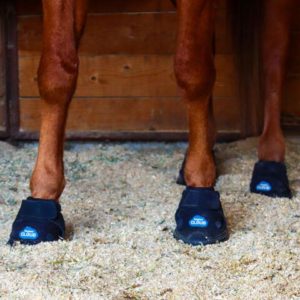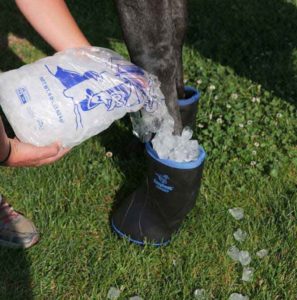For many of us in the horse industry, this time of year is synonymous with foaling season. The anticipation, the late nights, the false alarms, the worry, the excitement, the panic… so many conflicting emotions. All we can really do is try to be as patient and as prepared as possible.

Have you ever considered that having some EasyCare therapy boots on hand would be a great addition to your foaling kit?
The Easyboot Cloud could make your mare just a little more comfortable as she’s carrying around all that extra weight. And if it becomes necessary post-foaling, the Cloud could also help prevent any laminitic issues that may come with having a prolonged retained placenta.
A retained placenta can occur in as many as one out of every ten deliveries. Many times, all it takes to cure the condition is the administration of some oxytocin (a hormone that causes uterine contractions) if the placenta still hasn’t passed three or four hours after foaling. However, if oxytocin doesn’t cut it and the placenta is still retained or partially retained at eight to twelve hours post-foaling, this condition can get pretty dangerous for your mare.

According to Dr. Alana King in her article, “Managing Retained Fetal Membranes in Mares,” featured on The Horse:
“Because the placenta is no longer a viable organ postpartum, it begins to degenerate within the uterus, causing extensive bacterial overgrowth and toxin production. These bacteria and toxins can enter the mare’s bloodstream through the vascularized postpartum uterus and quickly cause sepsis (a body-wide infection) or endotoxemia (the potentially fatal presence of endotoxin in the bloodstream, released when bacterial cells disintegrate), sometimes as soon as 12 hours after foaling. This condition might be life-threatening and can also precipitate laminitis and founder.”
 EasyCare therapy boots can help prevent laminitis and founder when dealing with a prolonged retained placenta case. The Easyboot Remedy makes it easy to ice the hooves and fetlocks. And the Easyboot Cloud provides instant and ongoing relief for horses suffering from lower limb or hoof problems. What strategies have you used when you’ve had to treat a retained placenta?
EasyCare therapy boots can help prevent laminitis and founder when dealing with a prolonged retained placenta case. The Easyboot Remedy makes it easy to ice the hooves and fetlocks. And the Easyboot Cloud provides instant and ongoing relief for horses suffering from lower limb or hoof problems. What strategies have you used when you’ve had to treat a retained placenta?





